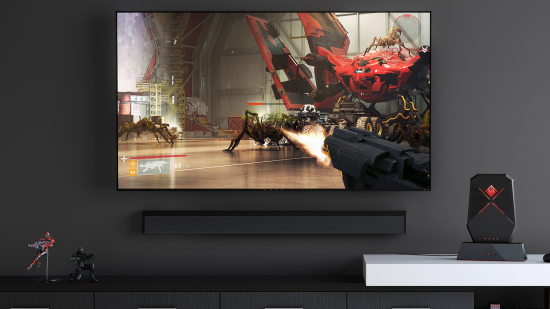Nvidia’s Big Format Gaming Displays might be delayed until Q1 2019. These gigantic G-Sync HDR gaming monitors were revealed at CES earlier this year as a follow-up to Nvidia’s also much delayed 4K HDR G-Sync monitors, and were expected to launch before the year’s up. Unsurprisingly, they are going to be incredibly expensive, too.
Nvidia’s BFGD will represent the very pinnacle of gaming monitor tech once they are on the market, fitted with Nvidia’s G-Sync HDR tech for a minimum of 1,000 nits of eye-scorching action, a 65-inch 4K panel, and a 120Hz refresh rate. Nvidia has even fitted it with an Nvidia Shield Android TV for easy 4K streaming.
AU Optronics will be manufacturing the panel itself, but you’ll see BFGDs from the likes of Asus, Acer, and HP Omen. We managed to catch up with the Omen team at Gamescom, who had an early engineering version at the event for us to take a look at. The monitor itself is very impressive, but all that tech looks like it will cost some serious dollar.
Our very own hardware chief bet heavy on a $4,000 price tag, and, sadly, he’s right on the money. Speaking to HP Omen at Gamescom 2018, the company told me it expects its own BFGD model, which includes a soundbar, to cost roughly €4,000 – maybe more if further features are added.
“We are not sure this is the final unit because we start shipping the device next year, January or February.” Kristian Sandor, EMEA Gaming Product manager at Omen, says. “…Maybe there will be some improvements along the way, maybe some new technologies to add in.
“Because we are still thinking about new technologies we don’t have the end price fixed, so we can say that it will be maximum €5K probably. Today, we can say that it will be maximum €4K, but if we will add more stuff inside we will go more expensive. It is not a cheap machine.”
The Asus PG27UQ, the first of Nvidia’s first 4K G-Sync HDR gaming monitors to go on sale, arrived with a launch price of some $2,000. This monitor, and the Acer Predator X27, were announced at CES 2017, but didn’t release until just a couple of months ago. With that in mind, it’s not all that surprising that the BFGD is neither cheap nor arriving by the summer as Nvidia had first intended. At least we will have the RTX 2080 Ti by that time to make good use of all the features the BFGD monitors have to offer.
But there may be a silver lining in all this. When we first managed to get hands-on experience with engineering samples of the BFGD back at CES there was still a long way to go in terms of panel performance, especially local dimming. The specs were far from finalised back then, so hopefully when January rolls around next year Nvidia will have had plenty of time to work out the kinks and can bring something to the market we can really rave about.

